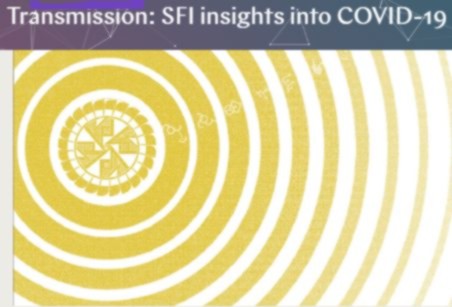| Complexity Explorer Adds Tutorial On Pandemic Prevention |
| Written by Sue Gee | |||
| Sunday, 26 April 2020 | |||
|
The latest resource on Complexity Explorer is an entry level tutorial about preventing pandemics. The Santa Fe Institute is also providing Transmission, an essay series of complexity science insights into the COVID-19 pandemic. Complexity Science is where modelling and data science confront real world issues. We've covered Complexity Explorer, the Santa Fe Institute's initiative to introduce complex systems to a wider, online, audience since it launched in 2013 and if you've not encountered it before see our reports The Joy Of Complexity MOOCS and Going Further Into Complexity With Santa Fe Institute. The new addition to Complexity Explorer, Pandemics, is based around two lectures presented in September 2019 - three months before the outbreak of COVID-19 - by Dr Lauren Ancel Meyers a member of the Santa Fe Institute External Faculty who is also the Cooley Professor of Integrative Biology and Statistics and Data Science at The University of Texas at Austin. She is a pioneer in the field of network epidemiology and the application of machine learning to improving outbreak detection, forecasting and control. Each live-recorded lecture is around 90 minutes in length. In the first, Outbreak detection, prediction, and containment in human social networks, Dr. Meyers introduces the field of network epidemiology, which applies tools from complex systems science to uncover fundamental drivers of contagion and pressure points for effective control. She explains how infectious diseases spread via encounters between people and show how by representing the essential structure of human connectivity in a mathematical framework, network epidemiology elucidates hotspots for transmission, early signs of an emerging threat, and ideal strategies for deploying vaccines, antiviral medications and social distancing interventions. The second lecture has the title The elusive threat of influenza and here Dr. Meyers takes us to the frontiers of influenza forecasting. Public health agencies struggle to predict seasonal epidemics and select the right virus strains for annual vaccines. Anticipating when and where a more deadly influenza pandemic might emerge is even more difficult. By leveraging network models and a growing ecosystem of health, social media and molecular data, scientists are chipping away at these critical challenges and confronting potentially insurmountable limits to predictability. For this tutorial an Introduction has been added. This consisting of a set of short readings followed by a quiz, plus a glossary of epidemiology terminology. Three short videos augment the glossary by illustrating Case-fatality rate, Basic Reproduction number R0, and the virus life cycle. Quizzes, consisting of 7 multiple choice questions, have also been devised for each of the two lectures and there's also a Discussion section with two topics - Influenza Pandemic of 1918 and Universal Influenza Vaccine with readings and questions.
If you are disappointed that this tutorial isn't specific to COVID-19 then the Santa Fe Institute does have material that is. Many of its researchers are involved in monitoring and modeling the pandemic, the development of vaccines and tests, and seeking to project the socio-economic impact of the disease as well as plotting paths to recovery. In March it started releasing a series of Transmission articles written by members of SFI with new batches published each Monday. These are intended to represent the Santa Fe Institute's real-time and ideas-based response to the COVID-19 outbreak and present ideas from complexity science to include: why systems collapse, the nature of an evolving virus and its ecology, how networks spread disease and economic instability, the mathematics of modeling outbreaks, the way decision-making modifies disease spread, and many other ideas that touch on the disease.
Comments
or email your comment to: comments@i-programmer.info |
|||
| Last Updated ( Monday, 27 April 2020 ) |





